Drum Point Light
Drum Point Light Station also known as Drum Point Lighthouse is one of four surviving Chesapeake Bay screw-pile lighthouses. Originally located off Drum Point at the mouth of the Patuxent River, it is now an exhibit at the Calvert Marine Museum.
 Drum Point Light, Calvert Marine Museum, December 2008 | |
| Location | originally off Drum Point at the mouth of the Patuxent River in the Chesapeake Bay; relocated to the Calvert Marine Museum |
|---|---|
| Coordinates | 38.319°N 76.421°W (approximate original); 38.331°N 76.463°W (current) |
| Tower | |
| Foundation | screw-pile |
| Construction | cast-iron/wood |
| Automated | 1960 |
| Height | 46 feet (14 m) |
| Shape | hexagonal house |
| Heritage | National Register of Historic Places listed place |
| Light | |
| First lit | August 20, 1883 |
| Deactivated | September 6, 1962 |
| Lens | fourth-order Fresnel lens |
| Range | 13 nautical miles (24 km; 15 mi) |
Drum Point Lighthouse | |
| Area | less than one acre |
| NRHP reference No. | 73000910[1] |
| Added to NRHP | April 11, 1973 |
History
Planning
In 1853, a report was filed by Lieutenant A. M. Pennock working for the United States Lighthouse Board. His survey mentioned that "a small light should be placed on Drum Point, inside of the Patuxent River." During storms, vessels would shelter there and several vessels had "brought up on the spit."[2]
On August 3, 1854, following that report, $5,000 funds were appropriated by Congress to build "a light-house on Drum Point, entrance of Patuxent River.". However, it was not used to build the project for 18 years.[2] In spite of subsequent requests by steamship operators, it was not until August 1882 that further funding would come. On August 7, 1882, Congress appropriated $25,000 for the "establishment of two range lights at the mouth of the Patuxent River." The funds were not adequate for such a project and it was never seriously considered for execution. The Lighthouse Service, due to the "smallness of the appropriation" decided to build a lighthouse as originally planned in 1854. A 5-acre (2.0 ha) offshore lot was obtained.[2][3][4]
Building
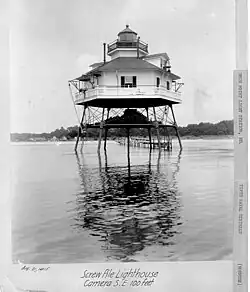
A screw-pile lighthouse design was selected by the Board. Work started on July 17, 1883. The ten-inch-diameter, wrought-iron piles were made by the Allentown Rolling Mills out of Philadelphia and fitted with three foot wide auger flanges. Once on-site, the seven piles were hand-bored into the bottom of the river. This part of the operations was completed by July 24, 1883.[2]
 Sectional of the Pile
Sectional of the Pile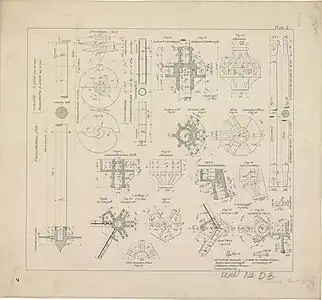 Foundation Pile and Castings
Foundation Pile and Castings
The house or "cottage" itself was then assembled. It had six sides, stood one and a half story. Made of wood it had mortised and tenoned joints. To protect it from the elements, it was sheathed with weatherboards. The exterior walls were painted white while the metal roof and pilings were painted red.[2]
On the main floor, it was divided in four rooms of roughly the same size:
- the sitting room
- the keeper's bedroom
- the dining room
- the kitchen[2]
For ventilation and light, two doors and six windows opened outward on a gallery surrounding the structure from which two iron ladders went down to the water's edge.
A central spiral staircase near the sitting room allowed access to the second floor where were located:
- the assistant keeper's room
- the bell room (located as far as possible from the keeper's room)
A flight of stairs led to the lantern room where the lens was housed.[2]
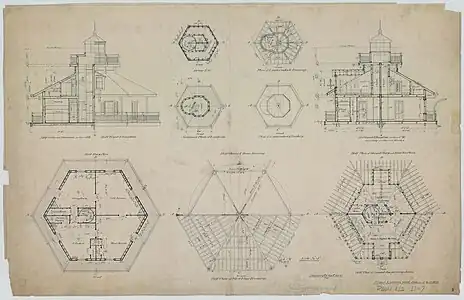 First Story Plan, Second Story and Roof Rafters Plan
First Story Plan, Second Story and Roof Rafters Plan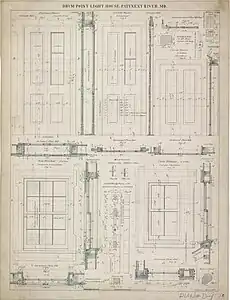 Entrance Doors, Inside Doors, Closet Doors and Windows
Entrance Doors, Inside Doors, Closet Doors and Windows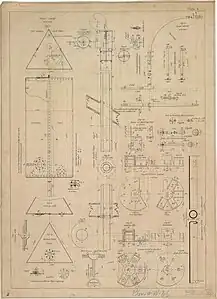 Water Tank, Boat Davit
Water Tank, Boat Davit
The prefabrication and the 10-foot depth of water allowed for the lighthouse to be built for only $5,000 as per the appropriation of 1853 and in only 33 days.[2]
Lens
The lens used were a Fresnel lens made by Henry Le Paute of Paris at a cost of $1,200.[2] It used a fourth-order Fresnel lens with prisms covering the 270 degrees needed to cover the area of water.[3] The focal plane of the beam was 47 feet above the water. On a clear night, it could be seen 13 nautical miles (24 km; 15 mi) from the deck of a vessel 15 feet above the sea.[2]
The light was originally a red light produced with a red chimney placed over the lamp. Due to its location on land, it only needed to be 270 degrees of width as the remaining 90 degrees were of land. At some point after 1909, the red chimney was replaced by a white one with 3 sheets of ruby red glass attached to the lantern room storm panes (windows). With the three red sectors, a vessel approaching the light could navigate the entrance of Patuxent River by staying in the white sectors of light. The light did not rotate or blink and was a steady beam.[2]
Bell
The bell weighed 1,400 lbs. It was embossed with its maker: "McShane Bell Foundary, Henry McShane and Co. Baltimore, Maryland, 1880."[2]
It was sounded with "2 blows at intervals of 15 seconds during thick and foggy weather." The responsibility of ringing the bell fell on the assistant light keeper who happened to have the room closest to the bell. According to an eye-witness, foxes would come to the beach to bark at the bell on foggy nights.[2]
Operation
The light was commissioned on August 20, 1883, when the first lightkeeper, Benjamin Gray light the light for the first time.[2][3]
Lightkeepers were provided with a copy of Instructions to Light-Keepers as well as other publications. The Instructions provided detailed instructions on how to operate the lighthouse as well as what was allowed to be had in the lighthouse. It declared that"articles known as luxurious are forbidden to be provided." According to John Hanson, Drum Point lightkeeper between 1942 and 1960, the U.S. Lighthouse Service only replaced the bristles on paint brushes and handles had to be reused while old rags and the brass bases of light bulbs had to be exchanged in order to receive replacements.[2]
A telephone was requested in 1919 by the keeper. After much correspondence and the keeper even offering to pay for it out of his own money, the Service allowed a telephone to be installed in 1923. However, it was to be listed under Drum Point Lighthouse and not be used by the keeper for his "convenience".[2]
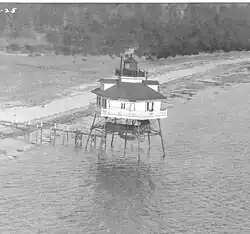
A privy on the edge of the gallery walkway was the only sanitary facilities on premise for some time. Later on, a bathroom was added to the main floor and sanitary facilities were installed probably in the 1950s. Fresh water was collected from rainwater with pipes on the roof. It was then collected in four 200 gallon cisterns in the cottage. If this was insufficient, more water could be had by walking to the Barreda House on a hill, one mile inland using buckets. Clothes were washed in saltwater.[2]
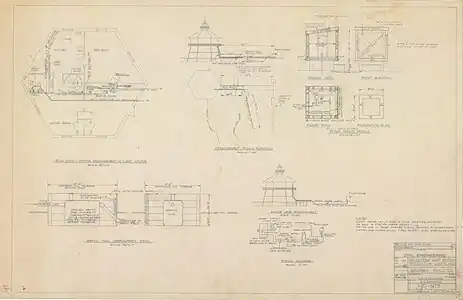 Sanitary Facilities plan from 1951
Sanitary Facilities plan from 1951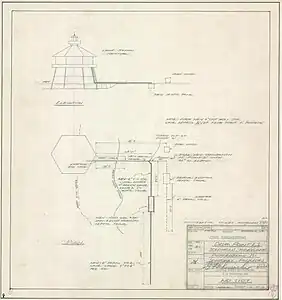 Alteration Plan to the Sanitary Facilities from 1959
Alteration Plan to the Sanitary Facilities from 1959
The risk of fire was extremely high due to the structure being made primarily of wood and the presence of a large quantity of oil used for the lighting of the lamps, cooking and heating. In 1932, the oil lamp was changed to an Incandescent Oil Vapor (I.O.V.) lamp to increase the power and range. It was later converted to electricity. Storms were also another source of danger. Unlike many such lights, Drum Point escaped ice damage.[3] However, it was reported on August 23, 1933, that the seas were "at least 15 feet high", flooding all the rooms on the lower deck, leading to significant damage and sinking the lighthouse's small boat.[2][3]
Birds were an issue as at other lighthouses. They were attracted to the light and sometimes crashed in the glass storm panels. This was even more a problem during spring and fallmigrations and extra panes of glass were stored in the lighthouse to replace damaged panes.[2]
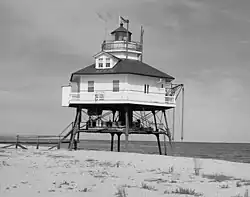
The light was converted to electricity in 1944.[3] This made life easier for the keeper but also would lead to the disappearance of the keeper as it did not need supervision overnight to make sure it stayed on.[2] The U.S. Lighthouse Service was transferred to the United States Coast Guard in 1939 and the lighthouse was one of the first to be automated in 1960 as part of a formal program of automating lighthouses.[2][3]
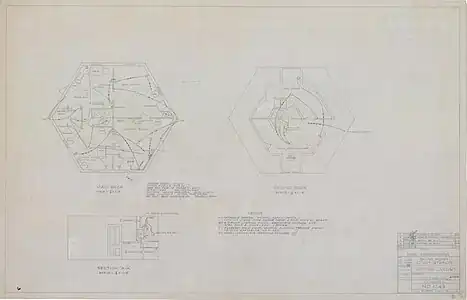 Wiring Layout from 1949
Wiring Layout from 1949
The light originally stood in 10 feet of water. The light was needed in the first place because of the considerable shoaling around the point. This gradually shifted the shoreline to the point where the light was entirely on land by the 1970s.[2][3]
Decommission and transfer of ownership
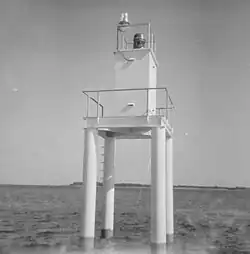
After 79 years of service, the light was decommissioned on September 6, 1962. It was replaced first by a lighted buoy, and latter by a fixed offshore light. Unlike other such conversions, however, the house was not torn down but simply abandoned. The Station was turned over to the State of Maryland. It was left abandoned for the elements and vandals to damage it further.[2] The State had plans to restore it and open access to the public. However, while the structure was the property of the State, the land needed to access it was still owed the General Services Administration (GSA) who administered it on behalf of the Federal Government. In addition, the access property was blocked by several miles of private property.[2][3]
The Calvert County Historical Society attempted to acquire the light as early as 1966 as a special project but had to navigate the State and Federal bureaucracy.[2] It was added to the National Register of Historical Places on April 11, 1973, in order to protect it. In 1974, the Society was informed that it could have the Drum Point Lighthouse but the land underneath it. With the help of the Calvert County Government, the property was transferred on December 10, 1974. By than, extensive damage had been done. It had been set on fire, an attempt had been made to steal the bell, the brass lens stand had been stolen and doors had been ripped from their hinges.[2]
Move
With a $25,000 grant from the State of Maryland, a contract was signed to move the lighthouse in one piece 2 nautical miles upriver to a new waterfront location accessible to the public at the Calvert Marine Museum which had opened in 1970. The B.F. Diamond Construction Company from Savannah, Georgia was constructing a bridge over the Patuxent River near Solomons at the time and a contract was signed to move the structure.[3][2]
A new foundation was prepared with work starting in February 1975. Due to the weather, construction was delayed by a month. Finally in March 1975, the move could begin. The area had to be "backwashed" with the tugboat in order to create a channel to access the now landlocked lighthouse. The cutting of the piles started using torches. It was discovered that the piles where made of solid steel and not hollow as previously thought. This further delayed the move as it took two days to cut through the metal forcing the barge and tug boat to go back to Solomons for the night.[2]
They returned the next day. With the use of a barge with a steam-operated crane, a square structure made of I-beams spreading cables was lowered on the lighthouse with only inches to spare from the roof. The cables were attached to the metal structure under the cottage and the final piles cut. The structure was raised under the eyes of people present including John Hansen, a former keeper.Two tug boats were used to pull the barge holding the 41 ton structure suspended. The trip took only 30 minutes as the lighthouse was moved to its new location where is stands today.[2]
The restoration was aided by funds from the National Park Service and the Maryland Historical Trust for the exterior and the structure. The interior was completely restored using period furniture under the advisory of Anna Weems Ewalt born in 1906 in the cottage. Along with a team of friends and volunteers, she went throughout the region looking for authentic furniture, often donated by Calvert County residents. She donated her grandmother's China set that was used at the time in the lighthouse along with Mr Hansen original chair. The original lens is on display at the museum.[2]
The Drum Point Lighthouse was rededicated as an exhibit on June 24, 1978, with Governor Blair Lee III in attendance.[2]
Fortuitously, the complete logbooks from 1883 to 1943 survive as well, providing an excellent glimpse into the life of a lighthouse keeper.[3]
Lightkeepers
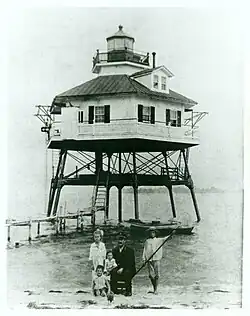
The life of a keeper at Drum Point was lonely and monotonous. It involved painting, cleaning and general upkeep. A keeper admitted he used the lower gallery walkway to run around as a way to break the monotony while another one, William Yeatman, who lived with his wife and daughter would salute all passing boats with three rings of the bell. Fortunately, the Drum Point Lighthouse was located only two nautical miles from Solomons for supplies. Some keepers planted vegetable gardens on the nearby point and at least one keeper kept chickens for eggs.[2]
Keepers sometimes had families. Wives and children lived in the station. Wives acted as assistant keeper and were not paid by the Service, saving on cost according to the report of a District Inspector. Two children were born at the lighthouse. Anna Weems Ewalt in July 1906 and Everett Yeatman around 1918. Two children died at the lighthouse and their caskets were lowered into boats from the station and taken to Solomons wharf.[2] At the turn of the 20th century, a small bridge was constructed from the light to the shore (as visible in the pictures below), allowing the keeper's family to live with him in the light.[3]
| Dates | Keeper | Yearly Salary (Start - Finish) |
|---|---|---|
| August 16, 1883 - October 27, 1890 | Benjamin Gray | $540 - $575[5] |
| October 27, 1890 - October 1, 1891 | William A. Bareford | $575 |
| October 1, 1891 - April 30, 1918 | James Locke Weems | $575 |
| December 15, 1917 - November 30, 1918 | James A. Dowell (Assistant Keeper) | $300 |
| 1918 | William Yeatman | $780[6] |
| 1919 - 1922 | Henry C. Wingate | $780[7] |
| July 25, 1922 - October 29, 1924 | Cale B. Stowe | $960 |
| October 29, 1924 - November 2, 1925 | unknown | unknown |
| November 2, 1925 - July 30, 1929 | James L. Lewis | $1,440 |
| 1930 - 1931 1931 | William M. Goeshy (Keeper) Beatrice E. Goeshy, his wife (laborer) | $1,320 - $1,440[8] $180[9] |
| December 1, 1931 - March 29, 1938 1937 | John J. Daley (keeper) Nelson S. Atherton (additional keeper*)[10] | $1,440 unknown |
| March 29, 1938 - July 31, 1938 | Gatha F. Cattee | $1,440 |
| August 1, 1938 - June 30, 1942 | Walther J. Westcott | $1,740 |
| July 1, 1942 - February 29, 1960 | John W. Hansen | unknown |
- helping with station duties when the primary keeper was injured.
References
- "National Register Information System". National Register of Historic Places. National Park Service. July 9, 2010.
- A Lighthouse for Drum Point by Dennis L. Noble and Ralph E. Eshelman - U.S. Lighthouse Society's The Keeper's Log - Summer 1987 - https://uslhs.org/sites/default/files/articles_pdf/Drum_Point_Lighthouse_US_Lighthouse_Society_The_Keepers_Log_Summer_1987.pdf
- "Historic Light Station Information and Photography: Maryland" (PDF). United States Coast Guard Historian's Office.
- Brinkman, Paul; Miller, Nancy (January 1972). "National Register of Historic Places Registration: Drum Point Light" (PDF). Maryland Historical Trust. Retrieved 2016-01-01.
- USLS - Chesapeake Chapter - Keeper Bio: Gray, Benjamin Nathaniel - https://cheslights.org/keeper-bio-benjamin-nathaniel-gray/
- USLS - Chesapeake Chapter - Keeper Bio: Yeatman, William - https://cheslights.org/keeper-bio-william-yeatman-jr/
- USLS - Chesapeake Chapter - Keeper Bio: Wingate, Henry Clay - https://cheslights.org/keeper-bio-henry-clay-wingate/
- USLS - Chesapeake Chapter - Keeper Bio: Goeshy, William Marion - https://cheslights.org/keeper-bio-william-marion-goeshy/
- USLS - Chesapeake Chapter - Keeper Bio: Goeshy, Beatrice Evelyn - https://cheslights.org/keeper-bio-beatrice-evelyn-goeshy/
- USLS - Chesapeake Chapter - Keeper Bio: Nelson Stanley Atherton - https://cheslights.org/keeper-bio-nelson-stanley-atherton/
- "Historic Light Station Information and Photography: Maryland" (PDF). United States Coast Guard Historian's Office.
- Drum Point Lighthouse, from the Chesapeake Chapter of the United States Lighthouse Society
- Drum Point Lighthouse at lighthousefriends.com
- Dodds, Richard J. "Drum Point Lighthouse - Its Origins Revisited" in Bugeye Times - the Quarterly Newsletter of the Calvert Marine Museum. Vol 18, No. 4 (Winter 1993/1994). Online copy here
- de Gast, Robert (1973). The Lighthouses of the Chesapeake. Johns Hopkins University Press. pp. 70–73. ISBN 9780801815485.
External links
![]() Media related to Drum Point Light at Wikimedia Commons
Media related to Drum Point Light at Wikimedia Commons
- Drum Point Lighthouse at the Calvert Marine Museum website
- Rowlett, Russ. "Lighthouses of the United States: Maryland". The Lighthouse Directory. University of North Carolina at Chapel Hill.
- Chesapeake Bay Lighthouse Project - Drum Point Light
- Drum Point Light, Calvert County, including photo from 1984, at Maryland Historical Trust
- Introductions to Light-Keepers - July, 1881 by the Light-House Board US Lighthouse Society


